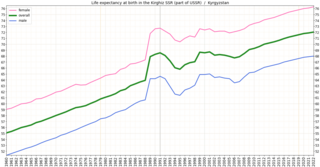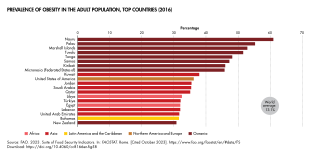Related Research Articles

Health care in Colombia refers to the prevention, treatment, and management of illness and the preservation of mental and physical well-being through the services offered by the medical, nursing, and allied health professions in the Republic of Colombia.
Health in the Comoros continues to face public health problems characteristic of developing countries. After Comoros's independence in 1975, the French withdrew their medical teams, leaving the three islands' already rudimentary health care system in a state of severe crisis. French assistance was eventually resumed, and other nations also contributed medical assistance to the young republic.

In the post-Soviet era, Kyrgyzstan's health system has suffered increasing shortages of health professionals and medicine. Kyrgyzstan must import nearly all its pharmaceuticals. The increasing role of private health services has supplemented the deteriorating state-supported system. In the early 2000s, public expenditures on health care decreased as a percentage of total expenditures, and the ratio of population to number of doctors increased substantially, from 296 per doctor in 1996 to 355 per doctor in 2001. A national primary-care health system, the Manas Program, was adopted in 1996 to restructure the Soviet system that Kyrgyzstan inherited. The number of people participating in this program has expanded gradually, and province-level family medicine training centers now retrain medical personnel. A mandatory medical insurance fund was established in 1997.

In terms of major health indicators, health in Paraguay ranks near the median among South American countries. In 2003 Paraguay had a child mortality rate of 29.5 deaths per 1,000 children, ranking it behind Argentina, Colombia, and Uruguay but ahead of Brazil and Bolivia. The health of Paraguayans living outside urban areas is generally worse than those residing in cities. Many preventable diseases, such as Chagas' disease, run rampant in rural regions. Parasitic and respiratory diseases, which could be controlled with proper medical treatment, drag down Paraguay's overall health. In general, malnutrition, lack of proper health care, and poor sanitation are the root of many health problems in Paraguay.

Niger is a landlocked country located in West Africa and has Libya, Chad, Nigeria, Benin, Mali, Burkina Faso, and Algeria as its neighboring countries. Niger was French territory that got its independence in 1960 and its official language is French. Niger has an area of 1.267 million square kilometres, nevertheless, 80% of its land area spreads through the Sahara Desert.
The current population of Myanmar is 54.05 million. It was 27.27 million in 1970. The general state of healthcare in Myanmar is poor. The military government of 1962-2011 spent anywhere from 0.5% to 3% of the country's GDP on healthcare. Healthcare in Myanmar is consistently ranked among the lowest in the world. In 2015, in congruence with a new democratic government, a series of healthcare reforms were enacted. In 2017, the reformed government spent 5.2% of GDP on healthcare expenditures. Health indicators have begun to improve as spending continues to increase. Patients continue to pay the majority of healthcare costs out of pocket. Although, out of pocket costs were reduced from 85% to 62% from 2014 to 2015. They continue to drop annually. The global average of healthcare costs paid out of pocket is 32%. Both public and private hospitals are understaffed due to a national shortage of doctors and nurses. Public hospitals lack many of the basic facilities and equipment. WHO consistently ranks Myanmar among the worst nations in healthcare.
Healthcare in Georgia is provided by a universal health care system under which the state funds medical treatment in a mainly privatized system of medical facilities. In 2013, the enactment of a universal health care program triggered universal coverage of government-sponsored medical care of the population and improving access to health care services. Responsibility for purchasing publicly financed health services lies with the Social Service Agency (SSA).

Health in the Central African Republic has been degraded by years of internal conflict and economic turmoil since independence from France in 1960. One sixth of the country's population is in need of acute medical care. Endemic diseases put a high demand on the health infrastructure, which requires outside assistance to sustain itself.
The Human Rights Measurement Initiative finds that Equatorial Guinea is fulfilling 43.5% of what it should be fulfilling for the right to health based on its level of income. When looking at the right to health with respect to children, Equatorial Guinea achieves 64.4% of what is expected based on its current income. In regards to the right to health amongst the adult population, the country achieves only 58.8% of what is expected based on the nation's level of income. Equatorial Guinea falls into the "very bad" category when evaluating the right to reproductive health because the nation is fulfilling only 7.3% of what the nation is expected to achieve based on the resources (income) it has available.
Public expenditure on health in the Gambia was at 1.8% of the GDP in 2004, whereas private expenditure was at 5.0%. There were 11 physicians per 100,000 persons in the early 2000s. Life expectancy at birth was 59.9 for females in 2005 and for males 57.7.
The Republic of the Congo faces a number of ongoing health challenges.

Health is the state of overall emotional and bodily wellbeing. Healthcare exists to provide healthiness to people and maintain their ideal conditions. In the Dominican Republic, health haphazardness has resulted in economic disgrace. It was because of the rising of infectious health disparities. Although healthcare institutions work tirelessly for the welfare of citizens, it is essential to note the prevalence of contagious diseases influences the Dominican economy.

After a significant decline in earlier decades, crude birth rates in Armenia slightly increased from 13.0 in the year 1998 to 14.2 in 2015; this timeframe also showed a similar trajectory in the crude death rate, which grew from 8.6 to 9.3. Life expectancy at birth at 74.8 years was the 4th-highest among the Post-Soviet states in 2014.
Life expectancy in East Timor at birth was at 60.7 in 2007. The fertility rate is at six births per woman. Healthy life expectancy at birth was at 55 years in 2007.
The Human Rights Measurement Initiative finds that Suriname is fulfilling 78.4% of what it should be fulfilling for the right to health based on its level of income. When looking at the right to health with respect to children, Suriname achieves 94.0% of what is expected based on its current income. In regards to the right to health amongst the adult population, the country achieves only 83.2% of what is expected based on the nation's level of income. Suriname falls into the "very bad" category when evaluating the right to reproductive health because the nation is fulfilling only 57.9% of what the nation is expected to achieve based on the resources (income) it has available.

In 2016, life expectancy in Tunisia was 74 years for males and 78 years for females. By comparison, in the 1960s it was only 47.1 years. Infant mortality in 2017 was 12.1 per 1,000 live births.
The Health in Eswatini is poor and four years into the United Nations sustainable development goals, Eswatini seems unlikely to achieve goal on health. As a result of 63% poverty prevalence, 27% HIV prevalence, and poor health systems, maternal mortality rate is a high 389/100,000 live births, and under 5 mortality rate is 70.4/1000 live births resulting in a life expectancy that remains amongst the lowest in the world. Despite significant international aid, the government fails to adequately fund the health sector. Nurses are now and again engaged in demonstrations over poor working conditions, drug stock outs, all of which impairs quality health delivery. Despite tuberculosis and AIDS being major causes of death, diabetes and other non-communicable diseases are on the rise. Primary health care is relatively free in Eswatini save for its poor quality to meet the needs of the people. Road traffic accidents have increased over the years and they form a significant share of deaths in the country.
Life expectancy in Fiji is 66 years for men and 72 years for women. Maternal mortality was 59 per 100 000 live births in 2013.

The Human Rights Measurement Initiative finds that Maldives is fulfilling 72.0% of what it should be fulfilling for the right to health based on its level of income. When looking at the right to health with respect to children, Maldives achieves 98.0% of what is expected based on its current income. In regards to the right to health amongst the adult population, the country achieves 99.7% of what is expected based on the nation's level of income. Maldives falls into the "very bad" category when evaluating the right to reproductive health because the nation is fulfilling only 18.2% of what the nation is expected to achieve based on the resources (income) it has available.

Expenditure on health in Samoa was 7.2% of GDP in 2014, US$418 per capita.
References
- 1 2 3 "Human Development Report 2009 – Honduras". Hdrstats.undp.org. Archived from the original on 29 April 2009. Retrieved 27 June 2010.
- ↑ "Honduras". WHO. 2018. Retrieved 19 November 2018.
- ↑ "Human Rights Measurement Initiative – The first global initiative to track the human rights performance of countries". humanrightsmeasurement.org. Retrieved 2022-03-18.
- ↑ "Honduras - HRMI Rights Tracker". rightstracker.org. Retrieved 2022-03-18.
- ↑ "Honduras - HRMI Rights Tracker". rightstracker.org. Retrieved 2022-03-18.
- ↑ "Honduras - HRMI Rights Tracker". rightstracker.org. Retrieved 2022-03-18.
- ↑ "Honduras - HRMI Rights Tracker". rightstracker.org. Retrieved 2022-03-18.
- 1 2 3 4 5 6 "Country Report: Honduras". paho.org. Retrieved 2018-12-04.
- ↑ Gorrell, Michael Gorrell (2011). "E-books on EBSCOhost: Combining NetLibrary E-books with the EBSCOhost Platform". Information Standards Quarterly. 23 (2): 31. doi:10.3789/isqv23n2.2011.07. ISSN 1041-0031.
- ↑ "Honduras: A Country Study". GPO for the Library of Congress. 1995. Retrieved 19 November 2018.
- ↑ "Grassroots Groups and NGOs Tackle Rural Healthcare Challenges in Honduras". Millennium Challenge Corporation. 9 July 2018. Retrieved 19 November 2018.
- ↑ "Situation of the Health System in Honduras and the New Proposed Health Model". Archives of medicine. 10 July 2017. Retrieved 19 November 2018.
- ↑ "HOSPITAL ESCUELA". Electives Network. 2018. Retrieved 19 November 2018.
- 1 2 "La Ceiba Medical Facilities". Honduras Travel. Retrieved 19 November 2018.
- ↑ "Hospital Militar". Hospital Militar. Retrieved 19 November 2018.
- ↑ "The Viera Hospital of Ayer". Viera Hospital and Clinics. Retrieved 19 November 2018.
- ↑ "Medical assistance". U.S. Embassy in Honduras. Retrieved 19 November 2018.
